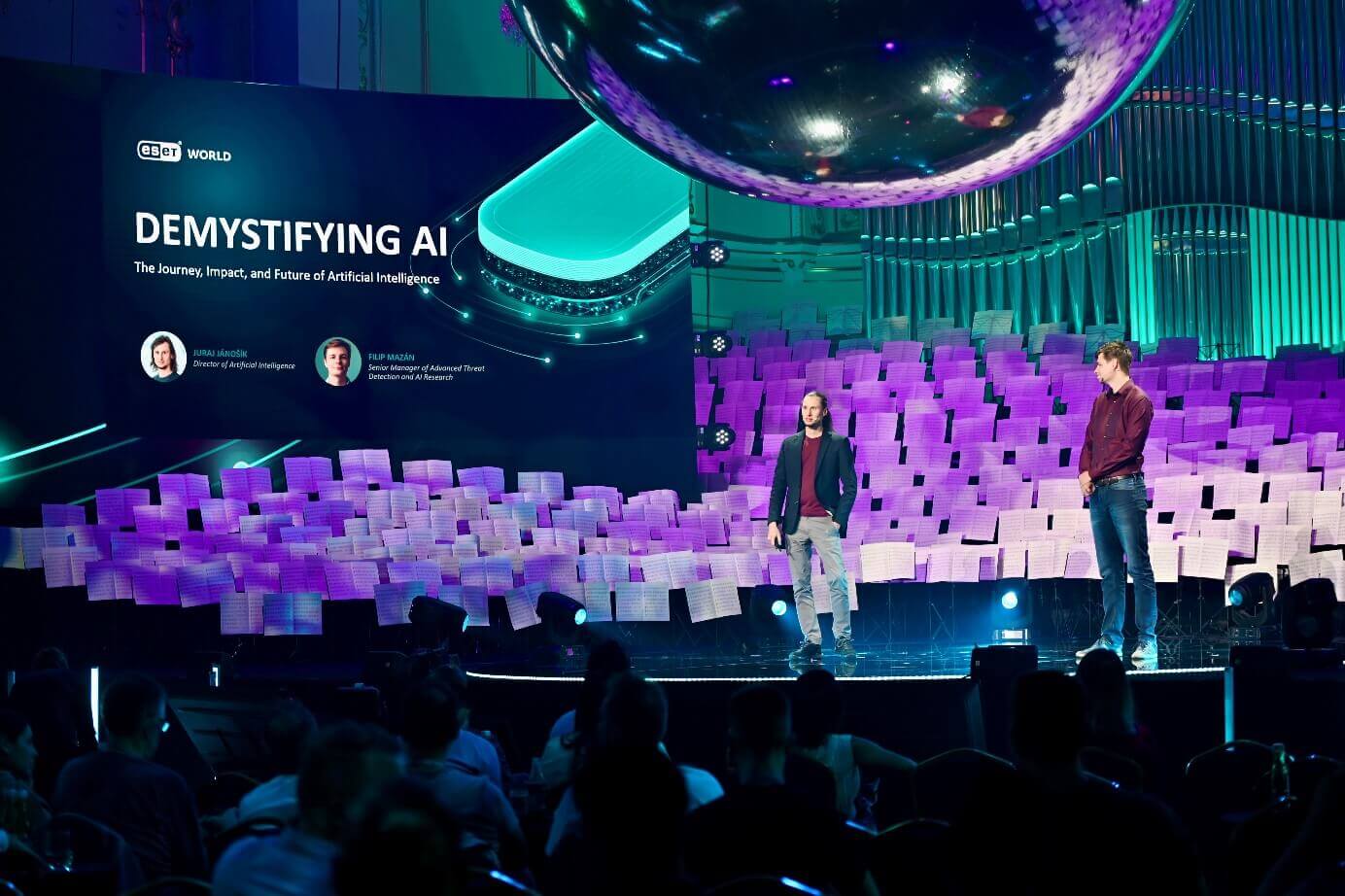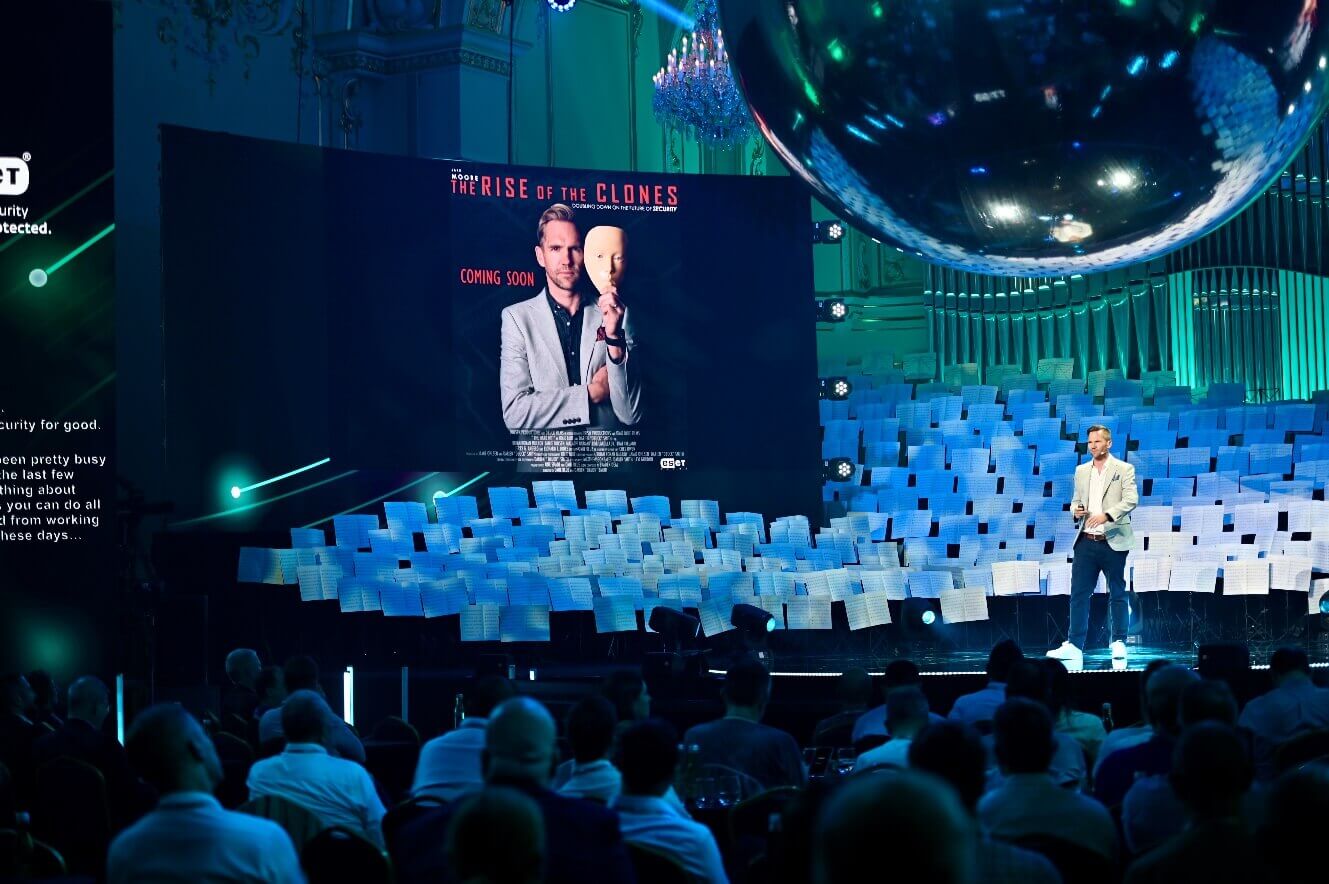Lots of of cybersecurity professionals, analysts and decision-makers got here collectively earlier this month for ESET World 2024, a convention that showcased the corporate’s imaginative and prescient and technological developments and featured numerous insightful talks concerning the newest traits in cybersecurity and past.
The matters ran the gamut, however it’s secure to say that the themes that resonated essentially the most included ESET’s cutting-edge risk analysis and views on synthetic intelligence (AI). Let’s now briefly have a look at some classes that coated the subject that’s on everybody’s lips as of late – AI.
Again to fundamentals
First off, ESET Chief Expertise Officer (CTO) Juraj Malcho gave the lay of the land, providing his tackle the important thing challenges and alternatives afforded by AI. He wouldn’t cease there, nonetheless, and went on to hunt solutions to a number of the elementary questions surrounding AI, together with “Is it as revolutionary because it’s claimed to be?”.

The present iterations of AI know-how are largely within the type of giant language fashions (LLMs) and varied digital assistants that make the tech really feel very actual. Nonetheless, they’re nonetheless relatively restricted, and we should totally outline how we need to use the tech with the intention to empower our personal processes, together with its makes use of in cybersecurity.
For instance, AI can simplify cyber protection by deconstructing advanced assaults and decreasing useful resource calls for. That means, it enhances the safety capabilities of short-staffed enterprise IT operations.
Demystifying AI
Juraj Jánošíokay, Director of Synthetic Intelligence at ESET, and Filip Mazán, Sr. Supervisor of Superior Menace Detection and AI at ESET, went on to current a complete view into the world of AI and machine studying, exploring their roots and distinguishing options.

Mr. Mazán demonstrated how they’re basically primarily based on human biology, whereby the AI networks mimic some elements of how organic neurons perform to create synthetic neural networks with various parameters. The extra advanced the community, the larger its predictive energy, resulting in developments seen in digital assistants like Alexa and LLMs like ChatGPT or Claude.
Later, Mr. Mazán highlighted that as AI fashions turn into extra advanced, their utility can diminish. As we strategy the recreation of the human mind, the rising variety of parameters necessitates thorough refinement. This course of requires human oversight to always monitor and finetune the mannequin’s operations.

Certainly, leaner fashions are typically higher. Mr. Mazán described how ESET’s strict use of inside AI capabilities leads to sooner and extra correct risk detection, assembly the necessity for speedy and exact responses to all method of threats.
He additionally echoed Mr. Malcho and highlighted a number of the limitations that beset giant language fashions (LLMs). These fashions work primarily based on prediction and contain connecting meanings, which might get simply muddled and end in hallucinations. In different phrases, the utility of those fashions solely goes up to now.
Different limitations of present AI tech
Moreover, Mr. Jánošík continued to sort out different limitations of latest AI:
- Explainability: Present fashions encompass advanced parameters, making their decision-making processes obscure. In contrast to the human mind, which operates on causal explanations, these fashions perform by means of statistical correlations, which aren’t intuitive to people.
- Transparency: High fashions are proprietary (walled gardens), with no visibility into their inside workings. This lack of transparency means there isn’t any accountability for a way these fashions are configured or for the outcomes they produce.
- Hallucinations: Generative AI chatbots typically generate believable however incorrect data. These fashions can exude excessive confidence whereas delivering false data, resulting in mishaps and even authorized points, corresponding to after Air Canada’s chatbot presented false information a couple of low cost to a passenger.
Fortunately, the bounds additionally apply to the misuse of AI know-how for malicious actions. Whereas chatbots can simply formulate plausible-sounding messages to help spearphishing or enterprise electronic mail compromise assaults, they aren’t that well-equipped to create harmful malware. This limitation is because of their propensity for “hallucinations” – producing believable however incorrect or illogical outputs – and their underlying weaknesses in producing logically linked and purposeful code. Consequently, creating new, efficient malware usually requires the intervention of an precise professional to right and refine the code, making the method more difficult than some would possibly assume.
Lastly, as identified by Mr. Jánošík, AI is simply one other software that we have to perceive and use responsibly.
The rise of the clones
Within the subsequent session, Jake Moore, World Cybersecurity Advisor at ESET, gave a style of what’s at present doable with the best instruments, from the cloning of RFID playing cards and hacking CCTVs to creating convincing deepfakes – and the way it can put company knowledge and funds in danger.
Amongst different issues, he confirmed how simple it’s to compromise the premises of a enterprise by utilizing a well known hacking gadget to repeat worker entrance playing cards or to hack (with permission!) a social media account belonging to the corporate’s CEO. He went on to make use of a software to clone his likeness, each facial and voice, to create a convincing deepfake video that he then posted on one of many CEO’s social media accounts.

The video – which had the would-be CEO announce a “problem” to bike from the UK to Australia and racked up greater than 5,000 views – was so convincing that folks began to suggest sponsorships. Certainly, even the corporate’s CFO additionally received fooled by the video, asking the CEO about his future whereabouts. Solely a single individual wasn’t fooled — the CEO’s 14-year-old daughter.
In a couple of steps, Mr. Moore demonstrated the hazard that lies with the speedy unfold of deepfakes. Certainly, seeing is now not believing – companies, and folks themselves, must scrutinize every part they arrive throughout on-line. And with the arrival of AI instruments like Sora that may create video primarily based on a couple of traces of enter, harmful occasions may very well be nigh.
Ending touches
The ultimate session devoted to the character of AI was a panel that included Mr. Jánošík, Mr. Mazán, and Mr. Moore and was helmed by Ms. Pavlova. It began off with a query concerning the present state of AI, the place the panelists agreed that the newest fashions are awash with many parameters and want additional refinement.

The dialogue then shifted to the fast risks and considerations for companies. Mr. Moore emphasised {that a} vital variety of individuals are unaware of AI’s capabilities, which dangerous actors can exploit. Though the panelists concurred that refined AI-generated malware is just not at present an imminent risk, different risks, corresponding to improved phishing electronic mail technology and deepfakes created utilizing public fashions, are very actual.
Moreover, as highlighted by Mr. Jánošík, the best hazard lies within the knowledge privateness facet of AI, given the quantity of information these fashions obtain from customers. Within the EU, for instance, the GDPR and AI Act have set some frameworks for knowledge safety, however that isn’t sufficient since these usually are not world acts.

Mr. Moore added that enterprises ought to make certain their knowledge stays in-house. Enterprise variations of generative fashions can match the invoice, obviating the “want” to depend on (free) variations that retailer knowledge on exterior servers, presumably placing delicate company knowledge in danger.
To deal with knowledge privateness considerations, Mr. Mazán urged firms ought to begin from the underside up, tapping into open-source fashions that may work for easier use circumstances, such because the technology of summaries. Provided that these develop into insufficient ought to companies transfer to cloud-powered options from different events.
Mr. Jánošík concluded by saying that firms typically overlook the drawbacks of AI use — pointers for safe use of AI are certainly wanted, however even widespread sense goes a great distance in the direction of conserving their knowledge secure. As encapsulated by Mr. Moore in a solution regarding how AI needs to be regulated, there’s a urgent want to boost consciousness about AI’s potential, together with potential for hurt. Encouraging vital considering is essential for guaranteeing security in our more and more AI-driven world.



